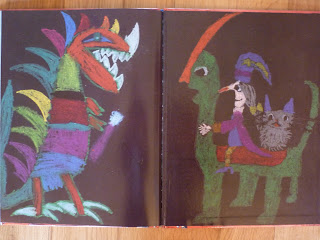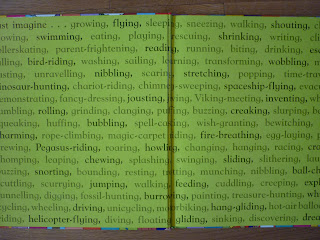In recent
years there’s been a trend for converting house attics into proper rooms. What had held dust and rats, water tanks and
junk, have become studies, en-suite bedrooms, artist’s studios, and more. Well, I think it is time to do the same thing
for picture books. There is a similarly
lovely big expanse of room that is often under-used in picture books, and
that’s the endpapers. We’re missing an
opportunity if we don’t use them.
Endpapers
are exactly that; the paper at the end of each book, joining cover to
content. That’s their job. Most endpapers are left as bare white paper, and useful for old-fashioned
library Return Due Date stickers to be stuck to, but that’s about all. I’ve noticed how often it is the blank endpapers of
library picture books which get scribbled on by small children. Are they trying to tell us something? “Use this space!” And some picture books do.
Korky Paul
cleverly hands-over the endpaper artwork to children. These pictures of Winnie the Witch and cat
Wilbur with dinosaurs are by Park Jung-Eum and Park Ji-Eun, aged seven. They are wonderfully bold, dramatic and fun
pictures which must give children a pleasing can-do feeling in knowing that
people of their own age can have good work published.
Jo Empson
uses the endpapers in Rabbityness to give a kind of rabbit wallpaper of
different rabbit poses; very attractive, and an appetiser for the
story to come.
Eileen
Browne uses the endpapers for Handa’s Surprise to show and name fruits at one
end of the book, and wild animals at the other end, adding interesting lessons to what is already one of the best picture book stories ever.
My You
Choose and Just Imagine books have illustrations crammed with images but have
little text. I was a child who found
reading hard, and was always relieved to find a book that didn’t demand much
reading. But there are children who
relish new words to read. So we’ve used the
endpapers to list hundreds of words, offering a kind of treasure hunt game for
those who like reading the words (they all name things to be found in the
pictures), but placed in the book so that they are not a necessary part of the
book experience if reading words isn’t something you enjoy.
Helen
Oxenbury’s beautiful pictures on the
endpapers of Farmer Duck are glorious.
Nothing ‘childish’ about them, and yet I’m sure that children sit and
absorb and lot from them, both for their beauty and for what they reflect from
the story. At the start we see the farm
landscape in winter; bleak and harsh. By
the end of the book that same scene has blossomed into warm colourful summer.
I’ve just
asked my editor if a new book that is (hopefully!) on its way to publication
might have a board game on its endpapers.
There are so
many way in which endpapers might add to picture books. They might add information relevant to a story, for example with
a map of where the story takes us, or non-fiction information relevant to the fictional
tale. They might add a game or an activity
to complement a story. How about a
recipe or a quiz, instructions on how to make a paper aeroplane, or black and
white pictures to be photocopied or traced for colouring in? Or simply add decoration to make a book more
beautiful.
When books are fighting for sales against so many other attractions, an extra ‘room’ in a book might just make it a winner. What other examples of extending stories into the endpapers have you found, or can you think of?







25 comments:
A great post and one that is very well timed for a picture book story I'm trying to 'save.' As it stands this book isn't working. However yesterday a solution hit me along with a brand new title. What also join this solution was the idea for carrying the story froward by using the end papers and getting the illustrator to complete the characters story for me.
P.S. Good luck for the new book.
V good post. I didn't know you wrote picture books too - I read 'Finding Fortune', your novel, recently and thought it was wonderful.
Great post!
I love the endpapers in the Winnie the Pooh books with the maps on them. I also love the endpapers in the Knufflebunny book, in which Mo Willems shows us the history of Trixie and Knufflebunny through family portraits.
Thank you, Lynne, although I've just learned from my editor that there can be problems with paperbacks when it comes to endpapers because some just don't have any. Hope the new ideas work, though!
Thank you, Anne. You've made me very happy! Finding Fortune is so new that I've not had many reactions to it yet, so to have a nice one from you is lovely.
Ah, yes! A classic and a modern example. Thank you, Colleen.
Have you seen Emily Gravett's "Blue Chameleon"? In that, the publisher's official information in the front has been twirled into the shape of a chameleon - I love it! And I'm fairly sure she uses the endpapers to some of her books.
Jane (W)
Emily Gravett is wonderfully inventive. Her Rabbit Problem books uses every inch of paper, with the story beginning on the inside of the cardboard cover, and the whole book working as a calendar which could hang on a wall!
Oh, you're so right, Pippa. Glorious endpapers really add to a book and I still remember the Farmer Duck end pages (we studied the differences between the front and back seasons).
I've been lucky that all the hardbacks of my books have delightful endpapers, eg biscuits in 'No More Biscuits' (of course!). However, when the hardbacks are published as paperbacks, the endpapers are sometimes moved inside or only half the double-page spread is used, or advertisements for other books are included (sometimes it can cheapen the book - it's not a magazine), which is a shame but I presume it's down to printing costs/page counts.
By the way, only one of my books has it, but I really like it when the publisher includes a pretty 'This book belongs to _____' box at the beginning.
Great post, Pippa. The poignant final endpaper in Michael Rosen's retelling of We're Going on a Bear Hunt pulls my heart-strings. I'm so glad he wrote a sort-of sequel for a happy ending!
Yes, a nice place for a child to proudly claim ownership is one of those nice things which an old fashioned paper book can offer, but which an ebook can't. There's something about a child's signature at different ages that takes us straight back to person we were when we got that book. Anne Fine's My Home Library downloadable array of pictorial book plates that she launched as Children's Laureate were, and still are, wonderful. See http://www.myhomelibrary.org/
Thanks, Janet! I do agree about the poignant bear, which I'm sure some children notice and care about. I wasn't aware of a sequel to Bear Hunt. Will go and hunt it out straight away!
Yes, I love the enchantment of well-used endpapers. But I've found that when I've suggested the story rolling on to the endpapers, I'm generally slapped down. It seems to be considered as a space reserved for the creativity of illustrator / designer. Should this be so? I'm not so sure.
You're probably right, though, Pippa, that they publishers might not want the endpapers to be integral to the story in case they're lost in paperback or in translation.
My new Walker book 'Too Noisy!', though, has delighful endpapers (with a cut out on the cover to see through to the title on the endpapers). It also has a page pre-the copyright page with an intro to the story 'Listen while I tell you / all about a bunch of Bungles - / they're a great enormous family / and they're noisy, / oh so noisy!'
Oh, I do love good design!
....A good design clearly inspired by a good text, Malachy! And, words aside, it's the author's story that is to be played with and developed visually by illustration and design. I love that peep-through idea.
The end papers in Jackie Morris's Tell me a Dragon are as inspirational as the rest of her wonderful book - tiny dragons hatching out of pebble-disguised eggs.
The end papers in Jackie Morris's Tell me a Dragon are as inspirational as the rest of her wonderful book - tiny dragons hatching out of pebble-disguised eggs.
The boardgame idea is brilliant, Pippa, and very inspiring. I've been lucky enough to have some really lovely endpapers, and they do make all the difference to a story.
Oo, that sounds nice! I can imagine, as a child, trying to copy those sorts of pictures. And that's another whole game. How about a 'how to draw' series of diagrams to show how to draw a key character in a book, propelling children into drawing their own stories for that character?
Thanks, Ragnhild. What excites me is that such different endpaper treatments would be suggested by, and appropriate for, different kinds of stories for different ages of children. Somebody should do a thesis on it!
Yesterday I got the first copies of my new picture book 'Stardragon' in the post, with a lovely busy scene of trees, with dragons and cats hiding in them. Although it's a paperback it has endpapers and little gatefolds, unusually - like the ones you'd get on a hardback book jacket. I don't know why it's different to normal, but the effect of the gatefolds is to bulk it out quite substantially. Perhaps it will catch on. As you say, Pippa, it's best not to include important story elements on the endpapers, but I love the idea of a board game, a 'how to draw' or a recipe, perhaps - and I always love maps. Truth is, I expect we'll get more and more advertising in books, to offset costs...
Good end papers are great. I do think that as authors, though, we need to be very careful about not incorporating story into it that might be lost in paperback editions. I also love the idea of a board game -a lot. I've got instructions for making a kite at the back of The Kite Princess but they're not quite end papers so they're there in hardback and paper back. Sadly in the current climate of cutting costs, I think there will be more advertising and more blank pages. Worth suggesting though when you have a good idea for them. Thanks, Clare.
I agree, Clare. We can suggest, but it will be the economics that probably decide whether or not these added elements to a book can be afforded. But surely it is exactly these extras that make a paper book so special, and should help paper books to fight back against ebooks?
Gorgeous post. I love the board game idea too :)
Hi Pippa, I missed this post when it came out but am commenting now ;-) If the endpapers are part of the artwork of the book, as in '12 spreads self ends' then the paperback will have them surely? Mine all do.
Great post. I love messing around with endpapers. It is a good place for illustators and designers to play ;-) I tend to do repeat patterns of the main character in various poses reflecting the content of the book without giving too much away. . . etc.
A board game would be great! Go for it!
Post a Comment